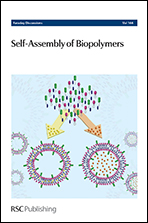Liposome and protein based stealth nanoparticles
Abstract
Liposomes and protein based nanoparticles were tuned with different polymers and glycolipids to improve stealth and thus decrease their clearance by macrophages. Liposomes were coated with polyethylene glycol (PEG) and brain-tissue-derived monosialoganglioside (GM1). Bovine serum albumin (BSA) nanoparticles were produced incorporating a PEGylated surfactant (PEG-surfactant). All obtained nanoparticles were monodisperse, with sizes ranging from 80 to 120 nm, with a zeta-potential close to zero. The presented stealth strategies lead to a decrease of internalization levels by macrophages. These surface modified nanoparticles could be used for production of new drug delivery nanosystems for systemic administration (e.g. intravenous application).
- This article is part of the themed collection: Self-Assembly of Biopolymers

 Please wait while we load your content...
Please wait while we load your content...